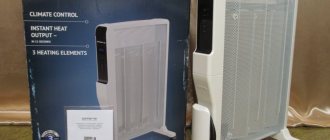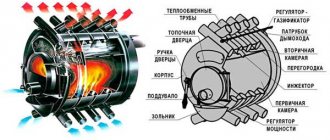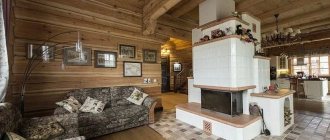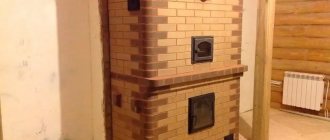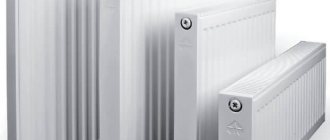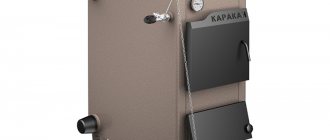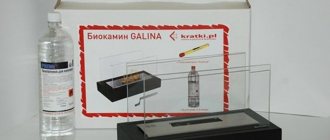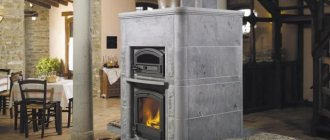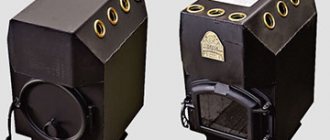The principle of operation of homemade stoves
If you simply set fire to any used oil, it will smoke mercilessly and “smell” even more intensely.
Therefore, direct combustion is not used. First, volatile substances are evaporated, then they are burned. This is the basic principle of design development. Therefore, in some versions, the stove has two combustion chambers connected by a tube in which holes are made. In the lower chamber, the fuel is heated and evaporated. Combustible vapors rise upward. Passing through a pipe with holes, they mix with oxygen dissolved in the air. Already in the upper part of this pipe the mixture ignites and burns out in the second chamber. Moreover, the combustion of vapors occurs with the release of much more heat and less smoke. With the right technology, there is practically no smoke, as well as soot.
Structure of a waste oil furnace with an air supply pipe
The second method of separating “heavy” fuel (oil of any origin) into “flammable” components is more effective, but also more difficult to implement. For efficient evaporation, a metal bowl is installed in the lower chamber. It heats up, and drops of waste falling on it instantly turn into volatile flammable vapors. In this case, the glow turns out (in the correct mode) white-blue, as when burning a plasma. This is where another name for this design comes from - with a plasma bowl.
To achieve the greatest efficiency of fuel combustion, used oil must be fed into the lower chamber in very small portions. In some variants - drops, sometimes - in a thin stream. That is why this technology is called drip feed.
Operating principle of a waste oil furnace with a plasma bowl
These are the basic principles of the “action” of homemade heating units. There are a very large number of their combinations and variations. Several of them are described below.
You can see an example of waste combustion in a plasma bowl in the video below. This is a Gecko mining furnace; it has a built-in water heater and can work as a heating boiler.
Features of the design of dropper furnaces
Such units consist of a rectangular or cylindrical body. Inside there is a combustion chamber, in the lower part of which there is a container intended for waste oil and holes that provide air flow.
After heating, the fuel evaporates, and then the vapors combine with the air in the chamber. The resulting mixture as a result of convection is directed upward through the firebox, where, when burned, it releases a significant amount of heat.
If desired, a water or air heat exchanger is built into the upper part of the drip furnace during processing, as a result of which it becomes possible to heat the room more evenly and better or to arrange a circuit for supplying hot water.
Drip supply occurs through a metal tube, which is connected to an oil evaporator. Its second end is brought out and connected to the tank with a flexible hose. In the upper compartment of the drip-type furnace during exhaust there is a smoke pipe, which is connected to the chimney.
Fuel supply system
We insert a ½ inch water pipe (1) (with a reserve) into the hole at an angle (30 - 40o), weld it to the stove body. The location of drilling the hole does not play a special role, since the evaporator bowl is made mobile and can be turned with the receiving hole in any direction.
We lower the coupling onto the end of the pipe and mark the outreach distance (2), cut it with a grinder, forming a “spout” for more convenient formation of a stream of oil (3).
A regular water ball valve (4) is screwed to the tube, which will be used as an emergency backup to shut off the fuel supply in the event of a failure of the valve on the exhaust tank.
(1)
(2)
(3)
(4)
Step-by-step instructions for making a waste oil stove with your own hands from a cylinder
The device can be made from old items using the presented drawings of a waste oil furnace. For this process you will need a gas cylinder with a capacity of 50 liters. You should also prepare:
- pipe with a diameter of 80-100 mm and a length of 4 m;
- steel corner for making a stand and internal elements of the heat exchanger;
- sheet steel for making the bottom of the upper chamber and the plug;
For the process of manufacturing a furnace using waste oil, you will need a gas cylinder with a capacity of 50 liters
- brake disk;
- fuel supply hose;
- clamps;
- half-inch valve;
- loops;
- half-inch oil supply pipe.
An empty gas cylinder is used to make the body. You need to unscrew the valve on it, after which you should leave it outside overnight to ventilate the remaining gas. A hole is drilled in the bottom of the product. To prevent the formation of a spark, the drill must be moistened with oil. Through the hole, the cylinder is filled with water, which is then drained, washing away the remaining gas.
Two openings are cut in the cylinder. The top one will be used for the combustion chamber, where the heat exchanger will be installed. The lower one acts as a burner with a tray. The upper part of the chamber is specially made large. If necessary, it can be filled with other fuel options in the form of firewood or pressed briquettes.
A stove made from a gas cylinder will be more economical and efficient than one made from other materials.
Next, the bottom for the upper compartment of the device is made from sheet metal 4 mm thick. A burner is made from a piece of pipe 200 mm long, as shown in the drawing of a waste oil stove. There are many holes made around the circumference of the product, which are necessary for air to enter the fuel. Next, sand the inside of the burner. This will eliminate the possibility of soot accumulating on the ends and uneven surfaces.
The furnace burner is exhausted from a gas cylinder and welded to the bottom of the upper chamber. If there are no mining reserves, wood can be laid on the formed shelf.
Making a tray for working off and installing a chimney for an oil stove with your own hands
According to the drawing of the stove, a cast iron automobile brake disc, which has good heat-resistant characteristics, is used to make a waste oil pan. A steel circle is welded in its lower part, which forms the bottom. At the top there is a lid through which air enters the oven.
A cast iron automobile brake disc is used to make the pan.
The next stage in the manufacture of a stove using waste oil from a gas cylinder is to make a coupling from a 10 cm long pipe that connects the burner and the pan. Thanks to this element, servicing the stove will be much easier. You can remove the tray and clean the bottom of the burner. To ensure the supply of oil, a metal tube is inserted into the hole in the housing and secured by welding. An emergency valve is installed on the pipe.
The chimney structure is made of a pipe with a diameter of 100 mm. One end of it is welded to the hole in the central upper part of the body, and the other is brought out to the street.
By watching the video “Furnace using a gas cylinder”, you can familiarize yourself with the sequence of actions in the manufacture of the device.
The principle of operation and advantages of such a stove
Fuel combustion in a waste oil furnace occurs in two stages. First, the fuel poured into the tank burns. The resulting gases are mixed with air. At the second stage, it is this gas-air mixture that burns, so the potbelly stove during mining consists of two compartments.
The design of the furnace for processing includes two combustion chambers, in one of which waste oil is burned, and in the other - a mixture of oil vapors and air
The first compartment is a tank into which used oil is poured. It burns at a relatively moderate temperature. Above there is another compartment, designed for the combustion of products mixed with air, formed during the combustion of waste. Here the process occurs at a much higher temperature, it can reach 800 degrees.
An important condition when building a potbelly stove for mining with your own hands is to ensure air access to both combustion chambers. For this purpose, a small hole is made in the lower tank, which serves to fill fuel, as well as to regulate the air supply. The hole is closed with a special valve. Secondary air usually enters the upper chamber through small holes (approximately 10 mm), which are drilled in the pipe connecting the tank and the second combustion chamber.
To ensure access of air to the second combustion chamber of the potbelly stove during mining, it is necessary to make small holes in the pipe connecting this chamber and the oil tank
The ability to use almost free fuel from waste oil is not the only advantage of such a unit. Thanks to the high combustion temperature, the exhaust furnace heats the room quickly and efficiently. If the device works correctly, it does not emit any unpleasant odors or substances hazardous to human health, therefore, from an environmental point of view, a potbelly stove during mining is considered completely safe.
However, the use of flammable substances in such a stove, for example, gasoline, solvent, etc., may pose a danger. It should also be remembered that some types of used transformer oil can release compounds harmful to health when heated.
Drawing of the simplest and most popular waste oil stove (click to enlarge)
Step-by-step manufacturing of the stove according to the drawing above
Owners of waste furnaces stock up on fuel in the summer. To do this, place a container in the garage into which the used oil is drained. By winter, quite a decent amount of fuel accumulates in it. Used oil can be obtained inexpensively or completely free from auto repair shops, service stations, etc.
Fire safety requirements
During testing, the furnace becomes hot and becomes a fire hazard, so you must comply with the requirements for its installation and operation:
- The floor surface must be fireproof. Concrete, ceramic tile, and metal surfaces are allowed. The wooden floor near the stove is covered with metal.
- If the wall next to which the stove is located is made of wood or other non-fire-resistant material, then it must be covered with an asbestos sheet.
- Do not allow drafts in the room where the stove is installed. Flames from a perforated pipe can spread to surrounding objects.
- Storing any flammable materials near the stove is prohibited.
- Mining reserves are stored in another room.
- Do not add fuel while the stove is operating.
- You should keep powder or salt fire extinguishers in a convenient place indoors.
A waste stove is an economical and convenient heating unit, which, with proper operation and installation of the water circuit, will significantly improve the indoor microclimate and will be an indispensable source of heat in a garage or workshop.
Increasing the efficiency of room heating
To increase the efficiency of heating the room, it is necessary to ensure a more intensive selection of excess heat from the stove. You can do this in two ways:
- forced airflow of the hot body - air heating;
- heating water and then pumping it into the heating system - radiator heating system.
Heat is removed from the upper zone, where the temperature reaches its maximum. Both options have already been developed and below are the most successful and simple designs of such stoves.
The photo clearly shows how the additional chamber for heating the air is organized. The partitions form a kind of labyrinth and lengthen the path through the heated zone. The air blowing chamber is welded on top of the upper combustion chamber. According to the developers, the efficiency of heating the room more than doubles.
Instead of an air labyrinth, you can weld a water boiler. The heated water will have to be pumped into the radiators, but the increase in the efficiency of heating the room is worth it.
Case manufacturing
I will make a stove from this cylinder
I used a used cylinder. There was no more gas in it, but just in case, I opened the valve and left the cylinder outside overnight.
Then I carefully and slowly drilled a hole into the bottom of the cylinder. To prevent sparks from appearing, I pre-moistened the drill with oil
Hole
Then I filled the bottle with water and drained it - this removed the remaining gas. Work carefully, try not to spill gas condensate, as... It stinks very strongly and for a very long time.
Then I cut out a couple of openings. In the upper opening I will make a combustion chamber and install a heat exchanger, in the lower opening there will be a burner with a tray. The chamber at the top is specially made so large that, if necessary, it can be heated with wood, pressed briquettes, etc.
Shown how I cut a balloon Shown how I cut a balloon Shown how I cut a balloon Shown how I cut a balloon In the end, this is what happened
Then I once again washed the opened gas cylinder from gas condensate.
Types of waste oil boilers and furnaces
The greatest demand is for mining furnaces with pyrolysis combustion type and turbo burners. Pyrolysis ovens have two chambers. In the first chamber, the oil is heated and decomposed into components when there is a shortage of air. The resulting vapors move to the second chamber, where, with full access to oxygen, they burn, releasing a lot of thermal energy. By adjusting the oxygen supply to the chamber, you can control the pyrolysis temperature. Such ovens require periodic cleaning, and maintaining the desired temperature in automatic mode is impossible.
As for turbo burners, they work like diesel engines. Oil is injected into the combustion chamber, vapors are released and ignite. However, this type of boiler is extremely sensitive to the purity of the oil; moreover, it must be preheated.
Depending on the design, waste furnaces can be:
- with drip oil supply;
- with blower;
- made from a gas cylinder.
What is mining
Waste oils are engine oils that have lost their beneficial properties for a car. During the replacement process, used fluids are sent to waste, so you can purchase fuel for the furnace at a low price and in large quantities. For the convenience of obtaining oil, enter into an agreement with the nearest auto repair shop.
The flow rate is 2 liters per hour. Depending on the size of the room and method of operation, the figure may vary. An oil-fired stove is suitable not only as a heater for a work area, but also heats water for various needs.
Advantages and disadvantages of using mining for heating
It is worth noting that, in terms of thermal power, the furnace during processing can be compared with an electric heater of 15 kW, and it will require about 0.5-2 liters of fuel per hour.
The principle of operation of the furnace using exhaust gas from a gas cylinder is to directly heat the air. It is advisable to use such units in large premises - winter gardens and greenhouses, garages, warehouses and repair shops. If, for example, a car service center constantly has a large supply of used oil, then it can be used for heating - there is no need to throw it away, and you save on resources.
Some of the benefits of working out include:
- absence of soot and burning during combustion;
- fire safety - only vapors burn, and not the used oil itself;
- ease of use.
This fuel also has a number of disadvantages, in particular:
- Unrefined used oil from a car service center cannot be used in boilers due to the large amount of impurities, since the main elements of the unit will become clogged. This is fraught with serious consequences, including an explosion. Cleaning cannot be done at home. Therefore, you need to purchase special prepared oil.
- By law, all enterprises that accumulate large amounts of used oil must enter into agreements for its disposal with special companies. These are paid services. Therefore, it is unlikely that you will be able to take away your work from them completely free of charge.
- At negative temperatures, the mining material freezes. Therefore, you need to find a storage place for it or deepen the container with oil into the ground, below the freezing level of the soil.
Features of heating structures during testing
The devices described in this article are often referred to as miracle stoves, because they use used oils (motor, transmission), which cost very little. Thanks to this, the operation of this type of furnace is cheap. The other miracle stoves that interest us will not operate on gasoline, diesel fuel, kerosene and other highly flammable mixtures.
“Exhaust” devices heat rooms by directly heating the air in them. From a constructive point of view, such a unit consists of two combustion compartments. In compartment No1, the used oil is burned, resulting in the formation of flammable vapors. After this, the vapors are fed into compartment No. 2, where they are mixed with air and, having a sufficiently high temperature, quickly burn, which is why large volumes of thermal energy are released.
In most cases, both compartments will be connected to each other using a pipe
It is important that holes with a diameter of about 10 millimeters are drilled in the latter - through them air will flow into compartment No. 2 for mixing with flammable vapors
Below are the main advantages of “working off” units.
- They are quite safe, since in this case it is the oil vapor that burns, and not the used oil itself.
- It is quite possible to make such a stove with your own hands, using cheap and affordable materials.
- Finally, such devices are easy to install and use, which is good news.
But there are also some disadvantages that anyone who plans to make a miracle stove on their own should know about.
- Only a warm room should be used to store used oil. At sub-zero temperatures it will simply freeze and lose all its properties.
- In addition, this oil must be specially filtered. It is prohibited to use simple contaminated waste from car services. It is almost impossible to clean contaminated oil at home.
List of popular stove models
Great demand for installations operating with waste creates supply on the market. The Belamos company, manufactured in Germany and Russia, can boast of good quality products. You can also highlight the following options for efficient heating:
Don't miss: How to properly heat a coal stove in a house - basic rules and features of the firebox
Emelya - exhaust heater with a power consumption of 40 W, capable of heating up to 200 sq.m.;
Heat pump NT 612 – positioned as a garage unit and suitable for small spaces;
Heat 25 – suitable for air heating with hot steam;
Master wa 33 – used for heating industrial premises;
Polarus - units from Polarus have a power adjustment function from 20 to 60 kW;
Euronord at 306 – drip design with a radial-type blower;
Typhoon is a heating device for garages, car services and workshops, thermal power ranges from 4 kW to 15 kW;
Herringbone - suitable for heating small rooms;
Thermobile at 306 – manufactured from Russia, technical or diesel fuel is used for operation;
Kronburg d15 is a convenient device at an affordable price that uses machine oil;
Multeat plus - products manufactured from Novosibirsk, are distinguished by smokeless combustion of the fuel mixture.
Some Belamos models are suitable for use in a bath; they do not emit black smoke if you follow all the rules of use. Stav products from Russia performed well. Many users learn about the features of using devices from the Thermoportal forum: stoves from various manufacturers are carefully discussed by their owners, highlighting the pros and cons.
Buleryan can be distinguished separately - the device operates in a combination of firewood and oil. To remake the model, you can arrange a door at the front of the installation to add a liquid component, and also make a reservoir. The Zhuchka stove is excellent for heating a car service center, as it is small in size and has low fuel consumption.
Ready-made installations or models made by yourself are beneficial to use: they save money, have low resource consumption and are affordable. Making the unit yourself is not difficult, and this model will last a long time.
The advantages of such a stove, and what disadvantages need to be taken into account
Waste oil furnaces with a water circuit come to the rescue in many cases and have their own advantages:
- This is a universal heating unit that is ideal for utility rooms, greenhouses, home workshops, garages;
- construction of a furnace is inexpensive (it can be assembled from scrap metal);
- warms up the room very quickly in any frost;
- compact design;
- can be adapted for heating and cooking;
- allows waste to be disposed of.
But there are also disadvantages that need to be kept in mind when operating the stove:
- requires regular cleaning of the chimney and combustion chambers, as during operation it is intensively covered with soot;
- it operates “loudly” and produces a hum when the fuel is actively burning;
- you need containers and a place to store used oil (it will freeze outside at sub-zero temperatures);
- the furnace is a fire hazard, since the body heats up to very high temperatures and the requirements for installation and operation must be strictly observed.
But all these disadvantages are not significant compared to fuel savings, especially if used engine oil is obtained free of charge. If all requirements are met, the stove will serve for a long time and safely.
Application area
In the standard version, a homemade stove heats the air well during testing. Such stoves are rarely used for heating in residential buildings, since oxygen is burned out from parts of the body that are heated to the limit.
- But these units are excellent for maintaining a comfortable temperature in industrial premises, as they quickly reach operating temperature.
- Therefore, you can often see such ovens in car repair shops, car washes, garages, various workshops, as well as in warehouses and greenhouses.
- Some craftsmen are remaking classic versions of waste furnaces: they can integrate a zigzag circuit for heating water.
- In this case, you get a real water furnace in production.
Features and principle of operation
It implements the principle of long-term combustion, based on the physical and chemical phenomenon of pyrolysis - the smoldering of fuel with a lack of oxygen and the combustion of gases released during this process. One load of firewood is enough for 4-8 hours of burning. The design of the stove is different in that the air supply pipe with a damper at the end is located vertically and exits through the top of the stove with a small, non-sealed gap,
The pipe has vertical mobility. At its lower end there is a massive disk with guides for the flow of gases. The chimney is welded to the top of the stove on the side. Firewood is loaded into the oven vertically, the disk presses it against the grate. As the lower layers of fuel burn, the disk lowers and combustion air is supplied to the upper layer of fuel, which is subjected to pyrolysis.
Advantages and disadvantages
The advantages of the Bubafonya top combustion stove are as follows:
- High fuel efficiency. Heat does not escape into the chimney.
- Ease of manufacture and operation.
However, the design also has disadvantages:
- It is impossible to replenish the fuel supply in the stove before it is completely burned.
- It is impossible to interrupt the combustion process.
- When the sand draft decreases, it smokes.
- Not suitable for quickly warming up cold rooms.
Necessary materials for making a bubafonya stove
The necessary materials are the same gas cylinder, fittings for the grate, a 90-degree pipe, a metal pipe one and a half meters long and a heavy disk with a diameter slightly smaller than the internal diameter of the gas cylinder.
Features of operation
During operation, it is important to remember the following: Firewood in layers must be of the same length, they should be loaded carefully and evenly, avoiding distortions
Diagram of a long-burning stove Bubafonya
For initial warming up and entering the pyrolysis mode, the stove requires an hour or more, and up to one fifth of the fuel is consumed.
General operating principle
If we want to get high-quality heating based on waste, we cannot simply take the oil and set it on fire, as it will smoke and stink. To avoid these unpleasant and hazardous side effects, you need to heat the fuel so that it begins to evaporate.
Volatile substances obtained as a result of heating will burn. This is the basic principle of operation of the heating unit during testing.
Application of perforated tube
To implement this principle, the design of the stove includes two chambers, which are connected to each other by a pipe with holes. Fuel enters the lower chamber through the filler hole, which is heated here. The resulting volatile substances rise up the pipe, becoming saturated with air oxygen through the perforation.
A schematic diagram of a two-chamber stove with a connecting perforated pipe allows you to understand exactly how a simple unit functions during mining
The resulting combustible mixture ignites in the chimney, and its complete combustion occurs in the upper afterburning chamber, separated from the chimney by a special partition. If the process technology is properly followed, virtually no soot or smoke is generated during combustion. But the heat will be enough to warm the room.
Using the plasma bowl
In order to achieve maximum efficiency of the process, you can go a more complicated route. Let us recall that our goal is to separate volatile components from the fuel by heating it. To do this, a metal bowl should be placed in the only chamber of the unit, which must not only be heated, but heated.
Through a special dispenser, waste will flow from the fuel tank into the chamber in a thin stream or drops. Once on the surface of the bowl, the liquid will instantly evaporate, and the resulting gas will burn.
The efficiency of this model is higher, since fuel supplied by drip burns better, and the problem of topping it up during the operation of the furnace disappears by itself
If everything is done correctly, the combustion of gases should be accompanied by a bluish-white flame. A similar flame can be observed when a plasma burns, which is why the red-hot bowl is often called a plasma bowl. And the technology itself is called drip feed: after all, fuel must be supplied in exclusively small doses.
With all the variety of designs, the operation of all heating units using waste fuel is based on the principle described above.
Security measures
A stove for a working garage is a simple and inexpensive solution for heating a technical room. And if the garage is a workshop where people often come for oil changes, then there will be no problems with fuel - there will always be plenty of it
When using the oven, you should be careful:
- Do not light faulty stoves;
- Do not use gasoline, alcohol or other aggressively burning liquids for ignition;
- Do not overheat ovens;
- Do not leave equipment unattended;
- Do not touch hot elements;
- Keep a fire extinguisher nearby;
- Homemade stoves during testing must be tested in outdoor conditions.
Questions and answers
During the manufacturing and operation process, users have a lot of questions, many of which are the same and can be addressed immediately. Let's answer them:
Is it worth making a homemade stove if you can buy a ready-made one?
Everyone decides this for themselves. However, we must take into account that the cost of such a stove starts at $1,000 (simple model), and more complex samples cost about $8,000.
Is it possible to refuel the stove with gasoline, kerosene or diesel fuel?
No, the stove cannot be refueled with light fuels that can burn on their own - this will cause a fire with unpredictable consequences.
If the mining was not enough, where to buy it?
You can purchase used oil that has undergone treatment at service stations or specialized oil change points. It is inexpensive, and you should not be afraid of spending too much.
Are there other designs of similar furnaces?
There are a lot of gas generating plants. There are models made from ordinary cylinders and other containers. However, it is not recommended to start with them - they are quite large and pose a danger to inexperienced or unprepared users.
Will sheet steel not burn out at high heating powers?
It is recommended to use a sheet with a thickness of at least 4 mm, and for the top cover - 6 mm. This will extend the life of the metal. If possible, the best option would be to use stainless steel of the same size - it is much stronger and more durable.
Drawings and assembly diagram
The manufacture of the furnace begins with the lower chamber. It is combined in the stove with a fuel tank, on the lid of which there are special holes for filling the waste and for the pipe connecting the first chamber to the second.
According to the dimensions shown in the figure, parts of the primary combustion chamber are cut out, the edges are polished and welded. The walls are made from pipe blanks.
Corners are welded to them, which will become legs, and a sheet of metal is welded to the bottom. A hole measuring 10 cm is cut in the center, and another 6 cm on the side, closer to the edge. If desired, make a removable lid - this makes it easier to clean the tank.
In a pipe 36 cm long and 10 cm in diameter, up to 50 holes with a diameter of 9 mm are drilled evenly over the entire area of the pipe so that the air flow is the same on each side.
A pipe with holes made is welded perpendicular to the tank lid. An air damper is installed on the lower tank. It is secured with a bolt or rivet. Through this hole the furnace will be ignited and the waste will be poured.
The upper tank is made in the same way as the lower one. A hole with a diameter of 10 cm is made in the plate, which is attached to the bottom of the tank, offset to one of the edges. A piece of pipe with a large diameter from the hole is welded to the hole below just enough so that it can be placed on the perforated upper combustion chamber.
Since the lid of the upper tank is exposed to high temperatures, it is recommended to make it of metal with a minimum thickness of 6mm. A hole is made in the upper part of the tank for the chimney, which is opposite to the hole in the bottom. A thick metal plate is placed between them - a cut-off device. It is inserted closer to the chimney opening.
A pipe is welded to the top cover, which is then connected to the chimney. To improve the stability of the structure, a spacer from a pipe or angle is welded. The stove can be painted with metal paint that can withstand high temperatures.
Supercharged drip furnaces
A forced-air furnace is the same heating device, only equipped with a fan. It is located closer to the second combustion chamber. Supercharging ensures uniform heating of the room.
It is difficult to assemble a drip furnace. Industrial heating devices are equipped with the same mechanism. Models of this type reduce the amount of fuel used.
Modern craftsmen have learned to combine the drip mechanism with supercharging. However, it is strongly not recommended to assemble such a unit without the appropriate skills.
Popular options for pre-fabricated furnaces, their characteristics
The Teplamos NT-612 stove is often chosen as a device used for heating a garage. The power of such a drip fanless heater can vary between 5-15 kW. Fuel consumption is 0.5-1.5 l/hour.
This furnace for use in a garage is a closed type device. It is equipped with a chimney, an air supply pipe and a built-in tank designed for 8 liters of fuel. Fuel combustion occurs in the inner chamber. The operation of the device begins with electrical heating of the plasma bowl. When the required temperature is reached, fuel is supplied and air is forced into the combustion chamber. The average cost of the device is 30 thousand rubles.
Another popular model is the Zhar-25 (MS-25) stove. This device can operate not only on waste oil, but also on diesel fuel. The device operates from the electrical network, which powers the internal fan. The thermal power of the furnace varies from 25 to 50 kW. It is designed to heat a room up to 500 square meters. m. Maximum fuel consumption is 4.5 l/hour. The device has large dimensions. Its weight reaches 130 kg. This stove needs to be equipped with a good chimney. You can buy it for 45 thousand rubles.
The exhaust furnace is equipped with a chimney, an air supply pipe and a built-in tank
Do-it-yourself stove made of sheet metal and pipes
Depending on the type of device, the structure can be created from pipes of different diameters or from iron sheets. To work you will need the following tools:
- grinder with cutting and grinding wheel;
- sheet metal and pipes;
- welding machine and electrodes;
- metal corners;
- metal paint that can withstand high temperatures.
Before making a furnace for testing, a detailed drawing of the apparatus is made. You can create it yourself or use ready-made options that are easy to find on websites on the Internet.
The first step is to make the lower part of the chamber connecting to the fuel tank. It looks like a rounded or straight tank with a lid where two pipes are located. The first is used to supply oil, and the second is used to strengthen the pipe that goes into the middle part of the device. Elements for the tank are cut out with a grinder and connected according to the drawing.
Depending on the type of device, the structure can be created from pipes of different diameters or from iron sheets
The bottom and metal corners are welded to the walls of the tank, which act as the legs of the structure. To create a lid, a sheet of metal is taken and holes are made in it. The first, with a diameter of 100 mm, is located in the center; the second, 60 mm in size, is located closer to the edge. The lid should be removable, which will make cleaning the stove easier.
A pipe about 37 cm long and 100 mm in diameter is used to supply oxygen. It has holes along the entire length of the element necessary for the supply of oxygen. The pipe is welded perpendicular to the cover at the bottom of the apparatus. An air damper is fixed on it, which will be secured with a rivet or bolts. The hole under the damper should be 6 cm in size. It is intended for supplying oil and igniting fuel.
The design of the upper tank is carried out by analogy with the design of the lower tank according to the drawing of a furnace using waste oil with your own hands. The walls of the product must have a thickness of at least 350 mm. A bottom with a diameter of 10 cm is cut out of the bottom of the tank, which should be placed closer to the edge. A small piece of pipe with a diameter of 11 cm is welded to the bottom of the hole. This is necessary to connect the element to the gas combustion tank.
Before making a furnace for testing, a detailed drawing of the apparatus is completed
Since the top cover of the supercharged exhaust furnace is exposed to high temperatures, a metal sheet with a thickness of at least 6 mm should be used for its manufacture. There is an opening in the lid for the chimney pipe, which should coincide with the opening at the bottom of the container. Between these elements, a partition made of dense metal sheet is mounted, located near the smoke hole. A pipe is attached to the top of the lid, connecting to the chimney part. The self-production process can be seen in detail in the video of the furnace being tested.
What are dropper stoves made of?
Due to the fact that this type of unit has a simple structure, you can assemble a drip-type stove with your own hands from a sheet of iron, a gas cylinder and a used barrel. The only requirement for them is the presence of a wall with a thickness of at least 4 millimeters, otherwise the body will move during operation. A proven drawing of a furnace using a gas cylinder will help you assemble the furnace correctly and quickly.
The simplest and at the same time reliable way is to assemble a stove from a gas cylinder, since it has a durable body and can withstand high pressure and heat to high temperatures.
Assembly diagram of a pyrolysis furnace operating on waste.
This oven will consist of three main parts:
- Oil container with lid and flap;
- Combustion/pyrolysis chamber;
- Afterburner chamber.
It all culminates with a chimney. Its recommended length is at least three meters, but chimneys with a height of 4-5 meters work best.
The oil container is made from a piece of pipe with a diameter of 344 mm, its height is 100 mm. We weld a sheet metal lid on the bottom. Our top cover is removable, it is made from a pipe with a diameter of 352 mm - sides with a height of 600 are welded to it. In the cover we make a central hole for the combustion chamber with a diameter of 100 mm. We make a hole nearby with a diameter of 60 mm - it will serve as a blower. This hole is closed with a simple rotating lid.
By adjusting the clearance of the blower, we can regulate the intensity of combustion, which will affect the air temperature in the room. If you completely close the vent while the stove is running, it may go out.
We make an afterburning chamber - we use a pipe with a diameter of 352 mm and a height of 100 mm. In the lower part we make a hole with a diameter of 100 mm into which the combustion chamber pipe is inserted. In the top cover we make a hole with a diameter of 100 mm for the chimney. Inside, closer to the chimney opening, we weld a small partition 330 mm wide and 70 mm high. Our do-it-yourself oven is almost ready.
After completing all the work, check the tightness of all welds - this will allow you to count on maximum efficiency of the stove.
Check the performance of the resulting unit outside. This will protect you from possible fire and other accidents.
We start testing the furnace - we install it outside, pour the waste into an oil container, and add kerosene on top. Carefully set it on fire, leaving the ash pan open. After some time, the stove will return to operating mode - you can adjust the burning intensity using the blower. After this, the stove is moved indoors (it must be ventilated).
In order for heating to be as efficient as possible, install the furnace in a corner, and line the side walls with galvanized iron so that all the heat is reflected into the room.
